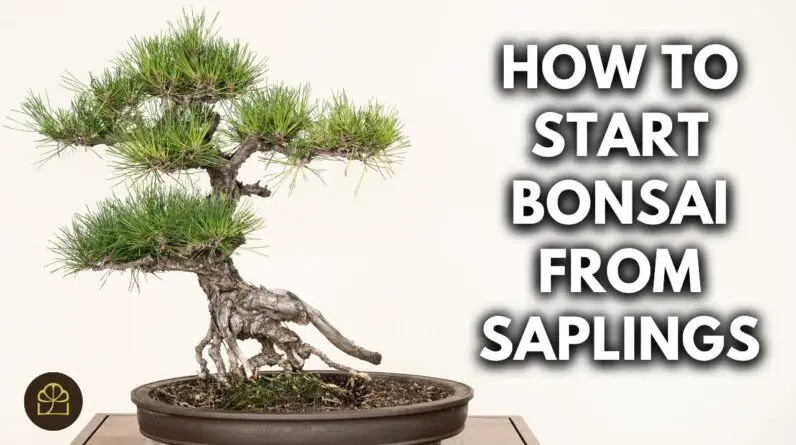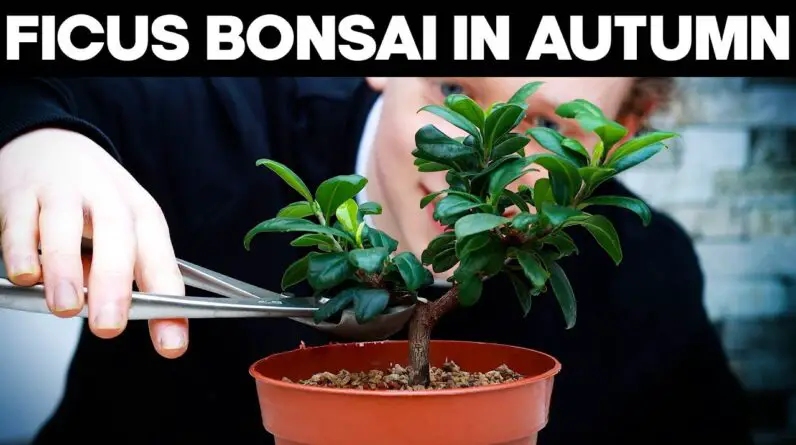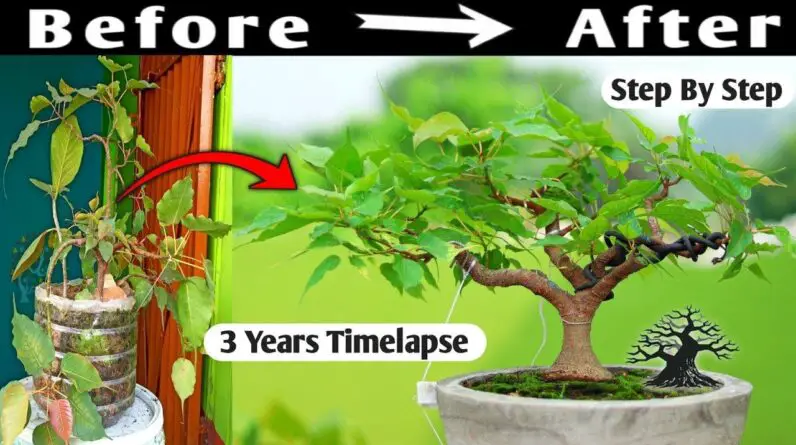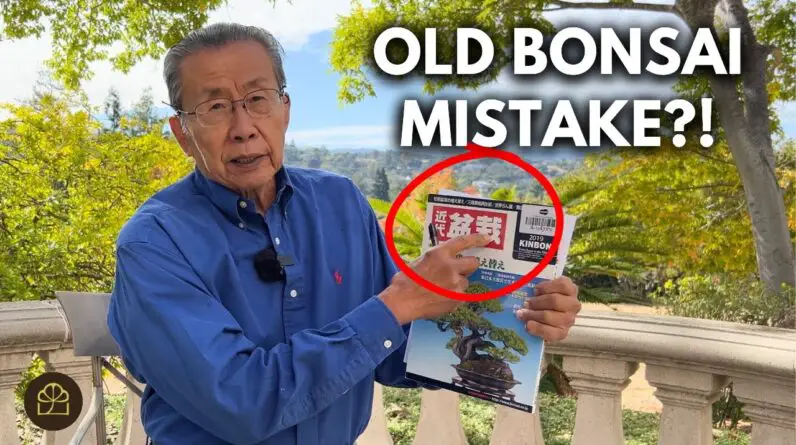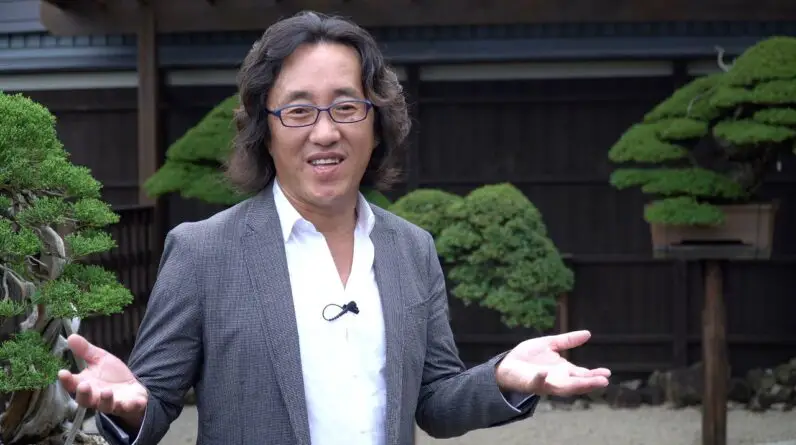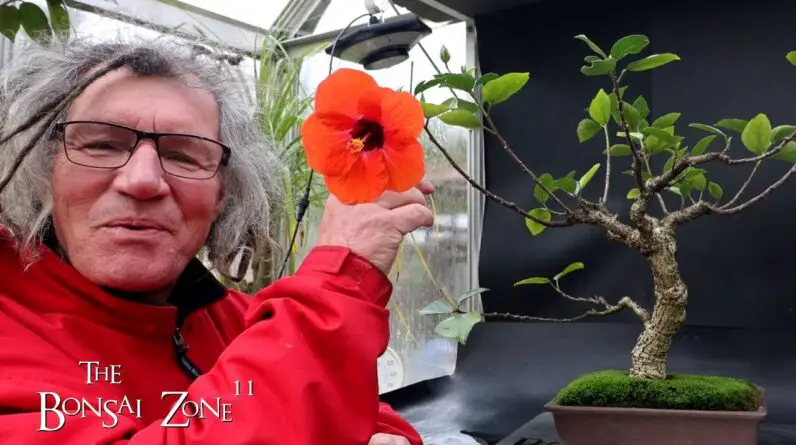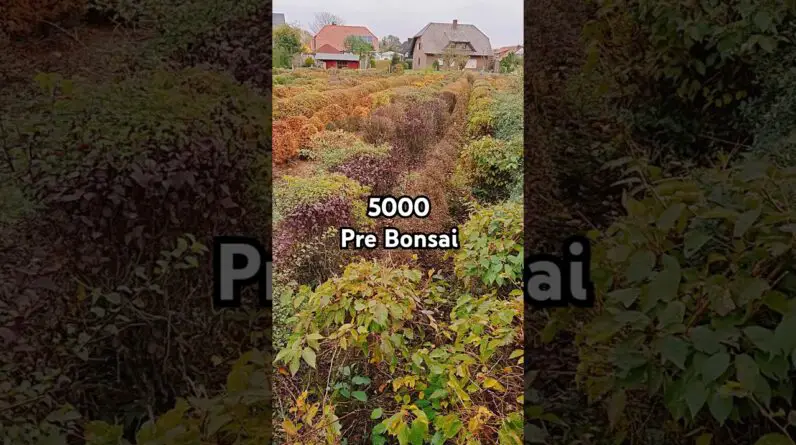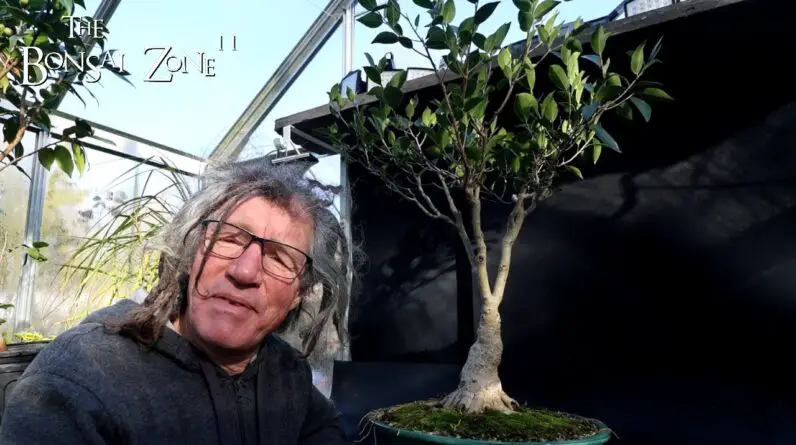Intend to learn just how to make an Apple bonsai tree? In this video by Bonsai Empire, they show you how to prune and wire an Apple tree that is around 15 years old. The video clip was filmed throughout autumn, when the tree was loaded with small apple trees.
Bonsai Empire is passionate regarding sharing the living art of Bonsai and developed this do it yourself tutorial to aid and inspire newbies. This video clip is part of their on-line courses, however they offer several various other totally free video clips too.
So if you want finding out more about Bonsai strategies, head over to Bonsai Empire’s website!
In the video, they explain the procedure of trimming and electrical wiring this Apple bonsai tree. They make use of small trimming shears, pliers, and cable cutters. The top branch is the initial to be trimmed, and afterwards they concentrate on 2 thicker branches to accomplish the preferred silhouette.
They show the value of a 360-degree strategy when cutting and electrical wiring to avoid any dead angles. After the pruning and circuitry, the tree looks extra polished and balanced. With normal maintenance, this tree will certainly continue to thrive and expand new branches in the upcoming springtime. If you want to learn more about pruning, wiring, and repotting methods, think about joining Bonsai Realm’s online courses and get to expert assistance and the chance to ask the trainers inquiries straight.
Apple Bonsai Tree: An Introduction
Invite to the world of apple bonsai trees! Producing and growing a miniature apple tree can be a fulfilling and meeting hobby. Not just do these bonsai trees give a beautiful visual, however they also supply the opportunity to grow your own fruits in a little and workable space.
In this comprehensive article, we will direct you with the procedure of selecting the best apple tree variety, collecting the needed products, growing the tree from seeds, trimming and circuitry techniques, correct upkeep, potting factors to consider, and the differences in between outside and indoor apple bonsai trees.
Take into consideration the Dimension of the Bonsai
When picking an apple tree variety for bonsai farming, it is essential to consider the supreme dimension of the tree. Since bonsai trees are suggested to be mini variations of their larger equivalents, selecting a range that normally remains little is crucial. Search for apple tree varieties that are known for their small development and smaller sized stature, such as columnar apple trees or naturally dwarf selections. This will make certain that your bonsai continues to be symmetrical and is easier to handle.
Pick a Crab Apple Tree Range
Crab apple trees, with their tiny and dynamic fruits, are typically the recommended choice for apple bonsai farming. These trees normally have much more delicate and symmetrical functions, making them appropriate for bonsai appearance. Furthermore, crab apple trees are hardy and adaptable, making them easier to take care of and maintain as bonsai samplings. Take into consideration varieties such as Malus sylvestris or Malus floribunda, which are frequently utilized in bonsai growing.
Take into consideration the Environment and Place
Before deciding on the apple tree selection for your bonsai, it is very important to take into consideration the climate and place where you prepare to expand it. Various apple tree varieties prosper in different environments, so select a selection that is well-suited to your specific region. In addition, remember the quantity of sunshine and temperature level needs of the selected variety. A lot of apple trees need full sunlight to prosper, so make sure that your picked place provides enough sunlight throughout the day.
Select a Suitable Bonsai Pot
Choosing the right bonsai pot is vital for the health and wellness and appearances of your apple bonsai tree. Look for a pot that is proportional to the dimension of your tree and enhances its total design. Bonsai pots come in different products such as ceramic, plastic, or clay. Each material has its own benefits and factors to consider, so choose one that matches your individual choices and the specific needs of your apple bonsai tree.
Get High Quality Bonsai Dirt
Premium bonsai soil is necessary for the healthy growth of your apple bonsai tree. The dirt must supply sufficient drainage while preserving enough wetness for the tree’s roots. You can acquire pre-made bonsai dirt blends that are particularly created for bonsai growing, or you can develop your very own mix by incorporating parts such as Akadama, pumice, and lava rock. Testing with various dirt mixes might be needed to locate the perfect balance for your apple bonsai tree.
Get Trimming and Electrical Wiring Devices
Pruning and electrical wiring are important techniques for forming and maintaining the type of your apple bonsai tree. To efficiently trim and wire your bonsai, you will certainly require a collection of proper tools. Some essential devices consist of a concave branch cutter for specific trimming, bonsai cord cutters for handling the cable, and pliers or tweezers for intricate job. Invest in high-quality devices to make certain precision and decrease damage to your apple bonsai tree.
Collecting Apple Seeds
Among the most fulfilling methods to start an apple bonsai tree is by growing it from seeds. You can accumulate apple seeds from ripe fruits or purchase them from respectable distributors. Make sure that the seeds are fresh and practical for the very best chances of germination.
Prep work of Seeds for Growing
Before planting the apple seeds, it is necessary to prepare them for optimum germination. Begin by soaking the seeds in water for 24 hr to soften the external seed layer. After soaking, get rid of the seeds from the water and enable them to dry for a few days. This procedure aids break the seed’s inactivity and increases the possibilities of effective germination.
Growing and Germination Refine
Once the seeds are prepared, plant them in little pots loaded with well-draining bonsai soil. Location the pots in a warm and bright place, and maintain the soil regularly damp. Germination generally takes about 2 to 4 weeks, depending on the variety and ecological conditions. As soon as the seedlings have sprouted, choose the healthiest ones to proceed expanding as your future apple bonsai trees.
Understanding Pruning Methods
Trimming is a critical element of bonsai cultivation that aids preserve the tree’s size, shape, and total aesthetics. By uniquely eliminating branches and foliage, you can attain the preferred type and balance. Learn more about various pruning strategies such as upkeep pruning, branch pruning, and squeezing to preserve the health and wellness and form of your apple bonsai tree.
Recognizing the Right Branches to Prune
When trimming your apple bonsai tree, it is very important to recognize the branches that need to be pruned. Seek branches that interfere with the wanted type or impede the tree’s total equilibrium. Eliminate any kind of dead, damaged, or unwanted branches to promote healthy and balanced growth and avoid condition. Get in touch with bonsai resources or look for advice from seasoned bonsai enthusiasts if you’re unclear which branches to prune.
Pruning to Attain Preferred Forming
Trimming is not only about upkeep yet also concerning forming your apple bonsai tree. Use trimming techniques to lead the tree’s growth and attain the wanted shape and design. Consider conventional bonsai shapes such as official upright, inclining, or waterfall, and adjust them to match the features of your apple bonsai tree.
Preparing the Tree for Wiring
Circuitry is one more necessary strategy in bonsai cultivation that aids produce and preserve the preferred shape and structure of your apple bonsai tree. Before using cables, make certain that the branches and trunk are versatile enough to be controlled without triggering damage. Younger branches are more flexible and easier to wire, while older branches may require gradual flexing gradually.
Selecting the Right Wire Size
Picking the suitable cable size is important to avoid harming the branches of your apple bonsai tree. The wire must be strong sufficient to hold the preferred form without cutting into the bark. Pick a cable size that is about one-third of the density of the branch being wired. Copper or light weight aluminum wire is typically utilized, yet see to it it is soft sufficient to be conveniently formed.
Using Circuitry Techniques
To wire your apple bonsai tree, beginning by covering the cord at the base of the branch or trunk and after that gently spiral it upwards, ensuring to preserve a 45-degree angle in between the wire and the branch. Take care not to cover the cord as well firmly, as it can limit the tree’s flow and cause damage. When the wanted form is attained, protect the cord by twisting the ends with each other or utilizing cable clips. Get rid of the cord after a few months to prevent it from cutting into the bark.
Watering and Moisture Control
Appropriate watering is essential for the wellness and vigor of your apple bonsai tree. The frequency and quantity of water required depend on different elements such as the climate, pot dimension, and tree’s growth phase. Water your apple bonsai tree when the top inch of soil really feels dry, ensuring that the water reaches the entire origin system. Prevent overwatering, as it can result in root rot and other fungal conditions.
Fertilizing and Nutrient Needs
Maintaining dirt fertility is necessary for the healthy and balanced growth of your apple bonsai tree. Use a balanced fertilizer during the expanding period to provide the necessary nutrients for ideal development. Usage natural or slow-release plant foods particularly created for bonsai trees, following the suggested dose directions. Regularly keep track of the tree’s reaction to fertilizing and change the feeding routine accordingly.
Insect and Condition Administration
Like any other plant, apple bonsai trees can be susceptible to different insects and diseases. Regularly examine your tree for signs of invasion, such as tarnished fallen leaves, insects, or uncommon development. If any concerns are found, quickly take appropriate steps to control and remove the issue. Take into consideration using organic bug control approaches or talk to professionals if essential.
Repotting Frequency and Timing
Repotting is a necessary task in bonsai cultivation that allows for root system wellness and total growth control. The regularity and timing of repotting rely on different variables such as the age and development price of the apple bonsai tree. As a general guideline, repotting is typically done every two to three years, ideally throughout the early spring before the tree starts proactively growing.
Picking an Appropriate Bonsai Pot
When repotting your apple bonsai tree, select a brand-new pot that is a little larger than the present one. Think about the visual appeals and general equilibrium of the tree when choosing the pot’s form and style. Guarantee that the pot supplies sufficient drainage openings and is made from a material that appropriates for bonsai farming.
Transplanting and Root Trimming
During repotting, carefully eliminate the tree from its current pot and carefully loosen up the origin sphere. Evaluate the origins and cut any broken or exceedingly long roots. This process, called origin pruning, aids stimulate new root growth and maintains the tree’s origin system portable. After root trimming, place the tree in the new pot, ensuring that the roots are evenly distributed and covered with fresh bonsai dirt.
Correct Potting Methods
When potting your apple bonsai tree, usage correct strategies to guarantee its security and healthy development. Placement the tree a little off-center in the pot to produce a feeling of motion and equilibrium. Safeguard the tree in position making use of bonsai cords or rocks, and load the staying room in the pot with bonsai dirt, making sure that no air pockets are left. Water the fresh potted tree extensively and monitor its recovery throughout the adhering to weeks.
Advantages and Factors To Consider for Outdoor Bonsai
Growing an exterior apple bonsai tree allows it to experience the natural changing seasons, which can enhance its overall beauty. Outdoor bonsai trees generally have more space to grow and develop a stronger root system. However, outdoor bonsai trees require careful consideration of climate and weather conditions, protection from extreme temperature fluctuations, and regular exposure to sunlight.
Benefits and Challenges of Indoor Bonsai
Growing an apple bonsai tree indoors provides more controlled conditions and allows enthusiasts in colder climates to enjoy bonsai cultivation year-round. Indoor bonsai trees require careful attention to temperature, humidity, and lighting conditions. Supplemental lighting may be necessary, especially during the winter months when sunlight exposure is limited. Additionally, indoor bonsai trees may require more vigilant pest and disease management due to the controlled environment.
Creating and caring for an apple bonsai tree is a rewarding and fulfilling endeavor. With proper knowledge and techniques, you can enjoy the beauty of nature in a miniature form and even grow your own miniature apples.
By choosing the right variety, gathering the necessary materials, mastering pruning and wiring techniques, maintaining proper care, and selecting the right pot and location, you can cultivate a stunning apple bonsai tree that brings joy and tranquility to your surroundings.
Happy bonsai cultivation!
[sspostsincat category=”Apple Bonsai With Fruit”]


